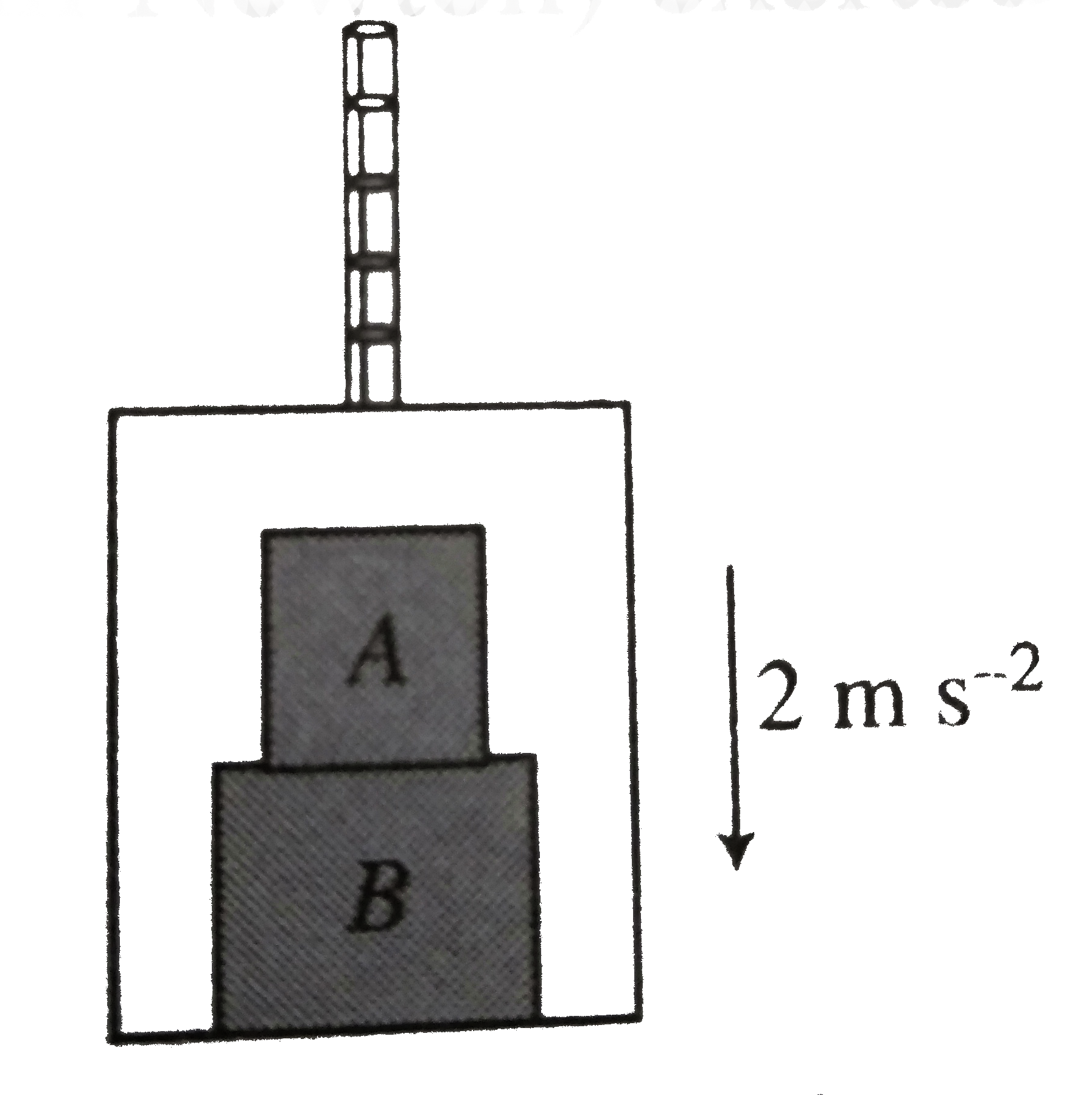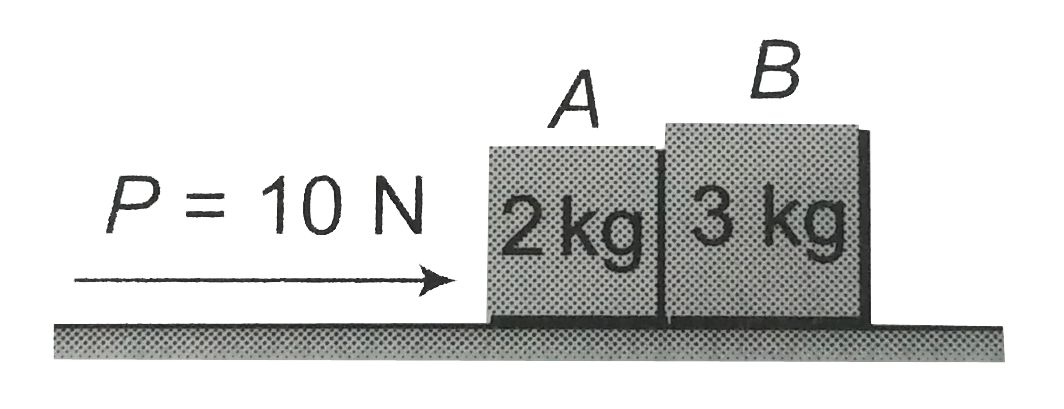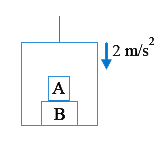A secret agent pushes two mysterious crates across a frozen river in the dark of night. The crates slide friction-lessly. Their masses are 150 kg (A) and 50 kg (B). The agent's hands exert a 100 N force on A (see Fig. 5-19). How much force does A exert on B? If there is no friction, can either block's acceleration be zero? Therefore, can ∑→Fon A=0? Therefore, can the force exerted on A by B (which is equal in magnitude to that exerted on B by A) "balance" (be equal and opposite to) the force exerted by the agent?

With no friction, the unopposed force exerted by the agent makes both crates accelerate. If crate A is accelerating, the forces on A cannot be equal and opposite.
Calculations: (a) To find a force on block B, we apply Newton.s second law to B. Using a free-body diagram of B (left), we get
sunFx on B=Fon B by A=mBαBx=mBαB. (5−21)
This leaves us with two unknowns, Fon B by A and αB.
(b) However, if we apply the second law to block A as well (see free-body diagram of A at left), we get
sunFx on A)=F_(onAbya≥nt)-F_(onAbyB)=m_(A)alpha_(Ax)=m_(A)alpha_(A).(5−22)
However, we know that Fon A by B=Fon B by A. Also, αA=αB (label this common acceleration a). Thus, from Eqs. (5-21) and (5-22), we get
Fon B by A=mBα (5−23)
and Fon A by agent−Fon B by A=mAα, (5−24)
which we can solve for the two unknowns Fon B by A and a. We use Eq. (5-23) to substitute for Fon B by A in Eq. (5-24):
Fon A by agent−mBα=mAα.
Then
Fon A by agent=mBα+mAα=(mB+mA)α
and
α=Fon A by agentmB+mA=100 N50 kg+150 kg=0.50 m/s2 (5−25)
Substituting this value and mA=50 kg into Eq. (5-23) gives us
Fon B by A=(50 kg)(0.50 m/s2)=25 N.
We have found that Fon B by A is one quarter of the force exerted by the hand on A. Likewise, mB is one quarter of the combined mass mA+mB pushed by the hand. As you sould expect from Newton.s second law of motion, to impart the same acceleration to a mass one-fourth as great requires one fourth the force.
Topper's Solved these Questions
- BOOK - RESNICK AND HALLIDAYCHAPTER - FORCE AND MOTION - I EXERCISE - CHECKPOINT5videos
FORCE AND MOTION - I
- BOOK - RESNICK AND HALLIDAYCHAPTER - FORCE AND MOTION - I EXERCISE - PROBLEMS52videos
FORCE AND MOTION - I
- BOOK - RESNICK AND HALLIDAYCHAPTER - FLUIDSEXERCISE - PRACTICE QUESTIONS (Integer Type )5videos
FLUIDS
- BOOK - RESNICK AND HALLIDAYCHAPTER - FORCE AND MOTION-IIEXERCISE - PRACTICE QUESTIONS (Integer Type)1videos
FORCE AND MOTION-II
Similar Questions
The elevator shown in fig. is descending with an acceleration of 2ms−2. The mass of the block A=0.5kg. Find the force (in Newton) exerted by block A on block B.
 View Solution
View SolutionA boy of mass 50 kg standing on ground exerts a force of 500 N on the ground. The force exerted by the ground on the boy will be :
View Solution
Knowledge Check
- Question 1 - Select One
The force exerted on an object is 200 N and its mass is 100 kg. Find the acceleration of the object.
A2ms−1B2ms−2C2ms1D20ms1 - Question 2 - Select One
Blocks A and B have masses of 2 kg and 3 kg. respectively. The ground is smooth. P is an external force of 10 N. The force exerted by B on A is
 A4 NB6 NC8 ND10 N
A4 NB6 NC8 ND10 N - Question 3 - Select One
The elevator shown in figure is descending, with an acceleration of 2m/s2. The mass of block A is 0.5 kg. the force exerted by block A on block B is (mass of block B is 1 kg)
 A2NB8NC6ND4N
A2NB8NC6ND4N

When F = 2n, the frictional force between 10 kg block 5 kg block isView SolutionTwo forces are applied to a 5.0 kg crate, one is 6.0N to the north and the other is 8.0N to the west. The magnitude of the acceleration of the crate is :
View SolutionA horizontal force F pushes a 4 kg block (A) which pushes against a 2 kg block (B) as shown. The blocks have an acceleration of 3m/s2 to the right. There is no friction between the blocks and the surfaces on which they slide. What is the net force B exerts on A ?
 View Solution
View SolutionThe elevator shown in fig. is descending with an acceleration of 2 m/s2. The mass of block A is 0.5 kg. The force exerted by the block A on the block B is
 View Solution
View SolutionP' and 'Q' horizontally push in the same direaction a 1200kg crate. 'P' pushes with force of 500 newton 'Q' pushes with a force of 300 newton If a frictional force provides 200 newton of resistance what is the acceleration of the crate. ?
View Solution

